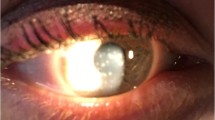Abstract
The microbial etiology of infectious corneal ulceration in Sierra Leone has been investigated. Patients either presenting to district health centers or encountered on rural surveillance expeditions with suspected infectious ulcerative keratitis were recruited into the study. Infectious corneal ulceration was defined as clinical evidence of corneal infection with epithelial defect with or without hypopyon. Cultures were obtained in a standard fashion and subsequent microbial analysis performed on all specimens. Seventy-three (73) cases of suspected infectious ulcerative keratitis were obtained between January 2005 and January 2006. The most commonly isolated organisms from microbial cultures of infected eyes were Gram-negative bacteria (45.2%), Gram-positive bacteria (37.0%), and fungal species (35.6%). Mixed bacterial and fungal organisms were isolated from ten eyes (13.7%) and no organisms were isolated from four eyes (5.5%). There is a high incidence of Gram-negative and fungal ulcerative keratitis in the population studied in Sierra Leone. Empirical therapy for corneal ulceration in this region should be aimed towards treatment of bacterial, fungal, and mixed infections.
Similar content being viewed by others
References
Cook JA (2008) Eliminating blinding trachoma. N Engl J Med 358:1777–1779
Epidemiology of onchocerciasis (1987). Report of WHO expert committee, Technical Report Series No. 752. World Health Organization, Geneva
Data on blindness throughout the world. WHO chronicle 1979; 33:275–283
Upadhyay MP, Karmacharya PC, Koirala S et al (1991) Epidemiologic characteristics, predisposing factors, and etiologic diagnosis of corneal ulceration in Nepal. Am J Ophthalmol 111:92–99
Srinivasan M, Gonzales CA, George C et al (1997) Epidemiology and etiological diagnoses of corneal ulceration in Madurai, south India. Br J Ophthalmol 81:965–971
Whitcher JP, Srinivasan M, Upadhyay MP (2001) Corneal blindness: a global perspective. Bull World Health Organ 79:214–221
Leck AK, Thomas PA, Hagan M et al (2002) Aetiology of suppurative corneal ulcers in Ghana and south India, and epidemiology of fungal keratitis. Br J Ophthalmol 86:1211–1215
Kotigadde S, Ballal M, Jyothirlatha et al (1992) Mycotic keratitis: a study in coastal Karnataka. Indian J Ophthalmo1 40:31–33
Gonzales CA, Srinivasan M, Whitcher JP et al (1996) Incidence of corneal ulceration in Madurai district, south India. Ophthalmic Epidemiol 3:159–166
Hagan M, Wright E, Newman M et al (1995) Causes of suppurative keratitis in Ghana. Br J Ophthalmol 79:1024–1028
Gugani HC, Talwar RS, Njoku-Obi AN et al (1976) Mycotic keratitis in Nigeria. A study of 21 cases. Br J Ophthalmol 60:607–613
Houang E, Lam D, Fan D et al (2001) Microbial keratitis in Hong Kong: relationship to climate, environment and contact-lens disinfection. Trans R Soc Trop Med Hyg 95:361–367
Gugani HC, Talwar RS, Njoku-Obi AN et al (1976) Mycotic keratitis in Nigeria: a study of 21 cases. Br J Ophthalmol 60:607–613
Khorozo D, Thompson R (1935) The bacterial flora of the normal conjunctiva. Am J Ophthalmol 18:1114
Singer T, Isenberg S, Apt L et al (1988) Conjunctival anaerobic and aerobic bacterial flora in pediatric versus adult subjects. Br J Ophthalmol 72:448–451
Gritz D, Scott T, Sedo SF et al (1997) Ocular flora of patients with AIDS compared to those of HIV-negative patients. Cornea 16:400–405
Tomar V, Sharma O, Joshi K (1971) Bacterial and fungal flora of normal conjunctiva. Ann Ophthalmol 3:669–671
Martins E, Alvarenga L, Hofling-Lima A (2004) Aerobic bacterial conjunctival flora in diabetic patients. Cornea 23(2):136–142
Capriotti JA, Pelletier JS, Shah M et al (2009) Normal ocular flora in healthy eyes from a rural population in Sierra Leone. Int Ophthalmol 29(2):81–84
Hammeke JC, Ellis PP (1960) Mycotic flora of the conjunctiva. Am J Ophthalmol 49:1174–1178
Ainley R, Smith B (1965) Fungal flora of the conjunctival sac in healthy and diseased eye. Br J Ophthalmol 49:505–515
Author information
Authors and Affiliations
Corresponding author
Rights and permissions
About this article
Cite this article
Capriotti, J.A., Pelletier, J.S., Shah, M. et al. The etiology of infectious corneal ulceration in Sierra Leone. Int Ophthalmol 30, 637–640 (2010). https://doi.org/10.1007/s10792-010-9348-1
Received:
Accepted:
Published:
Issue Date:
DOI: https://doi.org/10.1007/s10792-010-9348-1




